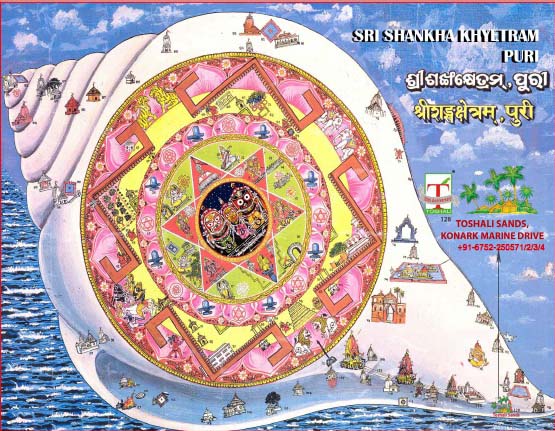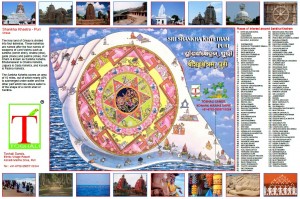The holy land of Orissa is divided into four kshetras. These kshetras are named after the four names of weapons of Lord Vishnu such as Shankha (conch shell), chakra (disc), gada (mace) and padma (lotus). Puri Dham is known as Shankha Kshetra. Bhubaneswar is Chakra Kshetra, Jajpura is Gada Kshetra, and Konark is Padma Kshetra (sometimes Ark Kshetra after the sun god)
The geographical size of Puri resembles a right oriented conch shell, the ‘Dakshinavarta Shankha’, which is why the name. The sacred section of puri looks like a conch shell and it is in this section that all the sacred centres like temples, mathas (English word for this), sacred tanks, trees and various other sacred sites are located. The Shankha Kshetra covers an area of roughly 10 square miles, out of which nearly 40% is submerged under the sea.
Tantric layout of Shankha Kshetra
Shankha Kshetra of Puri includes the Temple of Lord Jagannath and its huge compound circumscribed by a wall called Meghanada Pacheri. The temple complex is surrounded by streets or sahi, running in all directions from the temple. The sebakas (English word) live in the streets, which are close to the temple and monasteries, temples of several gods and goddesses, sacred tanks and trees, recreational and gymnastic centres (Jegaghar and Akhada (english word)) are located in different places scattered throughout the town.
The shape of the sacred section of Puri resembles a conch shell (Shankha) and, therefore, it is also known as the Shankha Kshetra. Like the other names, that is, Shri Khetra and Purusottam Khetra, which have bearing on the Lord Jagannath, the paramount deity of Puri, Shankha Kshetra has equal ritual and symbolic significance. The name Shankha Kshetra is the most significant because Shankha is one of the Aiyudhas or weapons of Lord Vishnu who resides in the navel or the central part of the shell in the form of Lord Jagannath. Shankha Kshetra is about 10 miles in extent, of which nearly two koshas are submerged in the sea and the remaining three koshas are above water.
In the centre of the Kshetra lies the hillock called Nilagiri where the famous temple of the Lord Jagannath stands. The broad end of the Shankha Kshetra lies to the west where the temple of Lokanath, one of the eight noted Shiva Temples of Puri is located and on the apical end or the cone in the east, is located another Shiva Temple called the Nilakantha. The area between the two temples is two miles and is the most sacred.

According to the Tantric philosophy, the Shankha Kshetra is made up of seven concentric folds.
- The innermost or first fold, which forms the navel, or the Kshetra, is the seat of the divine platform on which the Lord Jagannath with his elder brother Balabhadra and their sister Subhadra are presiding.
- The second fold, which is the outer layer of the first or the innermost fold, is hexagonal in shape and in this are located four goddesses of power, two tirthas, two sacred trees, Garuda (vehicle of Lord Vishnu) and the top of the Nilgiri hill which is convex like the back of a tortoise. The goddesses are Bimala, Kamala, Sarbamangala and Uttaral. The sacred trees are Kalpapadapa and Salmalitaru. The tirthas are Rohinikunda and Pranitodakakunda.
- The third fold, is the central part of the lotus-like structure having eight petals, each inlaid with an idol of Lord Shiva and a goddess. The eight Shivas are Agneswar, Bateswar, Khetrapaleswar, Chakreswar, Baikuntheswar, Pataleswar, Isaneswar, and Lokeswar. The eight goddesses are Dwarabasini, Mahabajreswari, Swanabhairabi, Bhadrakali, Bhubaneswari, Mahakaliaghorea, Sitala, and Jagnyeswari. These deities are responsible for watching and guarding the firstfold having the Supreme Lord at the centre of the sacred complex.
- The fourth fold, forms the convex surface of the temple precinct (Mahakurma) and the inner compound wall.
- The fifth fold, which is the outer layer of the fourth fold, is again the seat of another eight Shivas and eight goddesses. The Shivas are Bisweswar, Markandeswar, Mahakaleswar, Karnameswar, Mukteswar, Ugreswar, Kapilalochana and Agreswer. The goddesses are Bisweswari, Saptamatrika, Dakshinkali, Charchika, Alameswari, Barahi, Banadurgeswari and Basulikeswari. These deities are also in charge of watch and ward functions of the sacred complex.
- In the sixth fold of the sacred space there are four ashrams. They are Angirs in the east, Pandu in the west, Markandeya in the north, and Bhrigu in the south.
- The seventh fold which is the outermost zone consists of the sentries of the Shankha Kshetra and two pilgrim centres. That’s all or is it? Theres another legend. This place is named after demon Shankhasura who was killed by Lord Vishnu. Shankhasura was born from the sweat of demon Madhu. Vishnu killed Madhu when he was on the verge of killing Brahma. Shankhasura wanted to avenge Madhu’s death. He pleased Shiva by his penance and learned Tantra from him. While he was learning Tantra he could hear the recitation of veda. Rishi Yagnavalkya was learning Yajur veda from Brahma at the moment. Shankhasura wanted to learn the recitation and he asked Shiva for the source. Shiva instructed him to go to Brahma to learn the Vedamantra. But Brahma had already distributed the four Vedas among his disciples, so Brahma refused to teach him Vedamantra. Shankhasura was enraged and he took away the four Vedas from the disciples forcibly and hid them in the sea. Lord Vishnu took on the incarnation of “Meen” to search for the demon. The demon hid in the Kalpa Vriksha inside the present temple. Lord Vishnu tried to kill the demon. The demon hid in a conch. Vishnu used teh Sudarshan chakra but the hard conch diverted the chakra.
- Finally Vishnu killed the demon with his Brahmastra. Shiva was furious at the death of his disciple. The assembled gods pleased Shiva by singing “Vedasara Staba” (glories of Shiva). He requested Vishnu to name the place as Shankha kshetra after the name of Shankhasura. The proposal was accepted and the place was named as “Shankha kshetra”.

Toshali Sands has exclusive arrangement to take you to places of your interest in the “SHANKHA KHYETRAM” and “RATH YATRA” – THE CAR FESTIVAL. To Know more, contact Toshali Sands, Puri travel desk or leave your comment, we wil get back to you.
I would be glad to hear more about Shankha Khetram, please post if you feel any informations in the blog is missing. And would be gald to have you as their guest at Toshali Sands.
If you enjoyed this post, I would appreciate, if you share it on Twitter, Facebook, Orkut and other Social Networking sites.